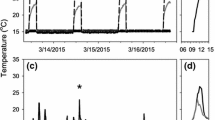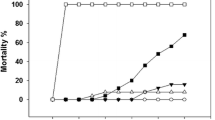Abstract
Climate warming involves not only a rise of air temperature means, but also more frequent heat waves in many regions on earth, and is predicted to intensify physiological stress especially in extremely changeable habitats like the intertidal. We investigated the heat-shock response (HSR) and enzymatic antioxidant defense levels of Patagonian shallow-water limpets, adapted to distinct tidal exposure conditions in the sub- and intertidal. Limpets were sampled in the temperate Northern Patagonia and the subpolar Magellan region. Expression levels of two Hsp70 genes and activities of the antioxidants superoxide dismutase (SOD) and catalase (CAT) were measured in submerged and 2- and 12-h air-exposed specimens. Air-exposed Patagonian limpets showed a tiered HSR increasing from South to North on the latitudinal gradient and from high to low shore levels on a tidal gradient. SOD activities in the Magellan region correlated with the tidal rhythm and were higher after 2 and 12 h when the tide was low at the experimental site compared to the 6 h value taken at high tide. This pattern was observed in intertidal and subtidal specimens, although subtidal individuals are little affected by tides. Our study shows that long-term thermal adaptation shapes the HSR in limpets, while the oxidative stress response is linked to the tidal rhythm. Close to the warm border of their distribution range, energy expenses to cope with stress might become overwhelming and represent one cause why the limpets are unable to colonize the shallow intertidal zone.







Similar content being viewed by others
References
Abele D (2011) Temperature adaptation in changing climate marine fish and invertebrates. In: Storey KB, Tannino K (eds) Temperature Adaptation in a Changing Climate. CABI Publishers, Wallingford, UK
Abele D, Puntarulo S (2004) Formation of reactive species and induction of antioxidant defense systems in polar and temperate marine invertebrates and fish. Comp Biochem Physiol A 138:405–415
Abele D, Tesch C, Wencke P, Pörtner HO (2001) How oxidative stress parameters relate to thermal tolerance in the Antarctic bivalve Yoldia eightsi? Antarct Sci 13:111–118
Abele D, Heise K, Pörtner HO, Puntarulo S (2002) Temperature dependence of mitochondrial function and production of reactive oxygen species in the intertidal mud clam Mya arenaria. J Exp Biol 205:1831–1841
Aebi H (1984) Catalase in vitro. Methods Enzymol 105:121–126
Andersen CL, Jensen JL, Orntoft TF (2004) Normalization of real-time quantitative reverse transcription-PCR data: a model-based variance estimation approach to identify genes suited for normalization, applied to bladder and colon cancer data sets. Cancer Res 64:5245–5250
Boveris A, Chance B (1973) The mitochondrial generation of hydrogen peroxide. Biochem J 134:707–716
Clark MS, Fraser KPP, Peck LS (2008a) Antarctic marine molluscs do have an hsp70 heat-shock response. Cell Stress Chaperon 13:39–49
Clark MS, Geissler P, Waller C, Fraser KPP, Barnes DKA, Peck LS (2008b) Low heat-shock thresholds in wild Antarctic inter-tidal limpets (Nacella concinna). Cell Stress Chaperon 13:51–58
Daufresne M, Lengfellner K, Sommer U (2009) Global warming benefits the small in aquatic ecosystems. Proc Natl Acad Sci USA 106:12788–12793
De Aranzamendi MC, Gardenal CN, Martin JP, Bastida R (2009) Limpets of the genus Nacella (Patellogastropoda) from the Southwestern Atlantic: species identification based on molecular data. J Molluscan Stud 75:241–251
Denny MW, Miller LP, Harley CDG (2006) Thermal stress on intertidal limpets: long-term hindcasts and lethal limits. J Ex Biol 209:2420–2431
Dong Y, Miller LP, Sanders JG, Somero GN (2008) Heat-shock protein 70 (hsp70) expression in four limpets of the genus Lottia: interspecific variation in constitutive and inducible synthesis correlates with in-situ exposure to heat stress. Biol Bull 215:173–181
Feder ME, Hofmann GE (1999) Heat-shock proteins, molecular chaperones, and the stress response: evolutionary and ecological physiology. Annu Rev Physiol 61:243–282
Fink AL (1999) Chaperone-mediated protein folding. Physiol Rev 79:425–449
Gracey AY, Chaney ML, Boomhower JP, Tyburczy WR, Connor K, Somero GN (2008) Rhythms of gene expression in a fluctuating intertidal environment. Curr Biol 18:1501–1507
Harley CDG, Hughes AR, Hultgren KM, Miner BG, Sorte CJB, Thornber CS, Rodriguez LF, Tomanek L, Williams SL (2006) The impacts of climate change in coastal marine systems. Ecol Lett 9:228–241
Hartl FU (1996) Molecular chaperones in cellular protein folding. Nature 381:571–580
Heise K, Puntarulo S, Pörtner HO, Abele D (2003) Production of reactive oxygen species by isolated mitochondria of the Antarctic bivalve Laternula elliptica (King and Broderip) under heat stress. Comp Biochem Physiol C 134:79–90
Helmuth B, Harley CDG, Halpin PM, O’Donnell MJ, Hofmann GE, Blanchette CA (2006a) Climate change and latitudinal patterns of intertidal thermal stress. Science 298:1015–1017
Helmuth B, Broitman BR, Blanchette CA, Gilman S, Halpin PM, Harley CDG, O’Donnell MJ, Hofmann GE, Menge B, Strickland D (2006b) Mosaic patterns of thermal stress in the rocky intertidal zone: implications for climate change. Ecol Monogr 76:461–479
Hoffman JI, Peck LS, Hillyard G, Zieritz A, Clark MS (2010) No evidence for genetic differentiation between Antarctic limpet Nacella concinna morphotypes. Mar Biol 157:765–778
Hofmann GE (1999) Ecologically relevant variation in induction and function of heat-shock proteins in marine organisms. Am Zool 39:889–900
Hofmann GE (2005) Patterns of Hsp gene expression in ectothermic marine organisms on small to large biogeographic scales. Integr Comp Biol 45:247–255
Jones DP (2006) Redefining oxidative stress. Antioxid Redox Signal 8:1865–1879
Lenormand T (2002) Gene flow and the limits to natural selection. Trends Ecol Evol 17:183–189
Lindquist S (1980) Varying patterns of protein synthesis in Drosophila during heat-shock: implications for regulations. Dev Biol 77:463–479
Lindquist S (1981) Regulation of protein synthesis during heat-shock. Nature 293:311–314
Lindquist S (1986) The heat-shock response. Ann Rev Biochem 55:1151–1191
Livingstone DR, Lips F, Garcia Martinez P, Pipe RK (1992) Antioxidant enzymes in the digestive gland of the common mussel Mytilus edulis. Mar Biol 112:265–276
Malanga G, Estevez MS, Calvo J, Puntarulo S (2004) Oxidative stress in limpets exposed to different environmental conditions in the Beagle Channel. Aquat Toxicol 69:299–309
Malanga G, Estevez MS, Calvo J, Abele D, Puntarulo S (2005) Oxidative stress in gills of limpets from the Beagle Channel: comparison with limpets from the Antarctic. Sci Mar 69:297–304
Moore M, Folt C (1993) Zooplankton body size and community structure: effects of thermal and toxicant stress. Trends Ecol Evol 8:178–183
Morley SA, Clark MS, Peck LS (2010) Depth gradients in shell morphology correlate with thermal limits for activity and ice disturbance in Antarctic limpets. J Exp Mar Biol Ecol 390:1–5
Murphy MP (2009) How mitochondria produce reactive oxygen species. Biochem J 417:1–13
Nakano T, Ozawa T (2007) Worldwide phylogeography of limpets of the order Patellogastropoda: molecular, morphological and palaeontological evidence. J Molluscan Stud 73:79–99
Osovitz CJ, Hofmann GE (2005) Thermal history-dependent expression of the hsp70 gene in purple sea urchins: biogeographic patterns and the effect of temperature acclimation. J Exp Mar Biol Ecol 327:134–143
Parsell DA, Lindquist S (1993) The function of heat-shock proteins in stress tolerance—degradation and reactivation of damaged proteins. Ann Rev Genet 27:437–496
Powell AWB (1973) The patellid limpets of the world (Patellidae). Indo-Pacific Mollusca 3:75–206
Reznick D, Butler MJ, Rodd H (2001) Life-history in guppies. VII. The comparative ecology of high- and low-predation environments. Am Nat 157:12–26
Sanders BM, Hope C, Pascoe VM, Martin LS (1991) Characterization of the stress protein response in two species of Collisella limpets with different temperature tolerances. Physiol Zool 64:1471–1489
Slatkin (1987) Gene flow and the geographic structure of natural populations. Science 236:787–792
Somero GN (2002) Thermal physiology and vertical zonation of intertidal animals: optima, limits, and costs of living. Integr Comp Biol 42:780–789
Somero GN (2005) Linking biogeography to physiology: evolutionary and acclimatory adjustments of thermal limits. Front Zool 2:1
Sorte CJB, Hofmann GE (2004) Changes in latitudes, changes in aptitudes: Nucella canaliculata (Mollusca: Gastropoda) is more stressed at its range edge. Mar Ecol Prog Ser 274:263–268
Storti RV, Scott MP, Rich A, Pardue ML (1980) Translational control of protein synthesis in response to heat-shock in D. melanogaster cells. Cell 22:825–834
Tomanek L (2002) The heat-shock response: its variation, regulation and ecological importance in intertidal gastropods (genus Tegula). Integr Comp Biol 42:797–807
Tomanek L (2008) The importance of physiological limits in determining biogeographical range shifts due to global climate change: the heat-shock response. Physiol Biochem Zool 81:709–717
Tomanek L (2010) Variation in the heat-shock response and its implication for predicting the effect of global climate change on species’ biogeographical distribution ranges and metabolic costs. J Exp Biol 213:971–979
Tomanek L, Sanford E (2003) Heat-shock protein 70 (hsp70) as a biochemical stress indicator: an experimental field test in two congeneric intertidal gastropods (genus: Tegula). Biol Bull 205:276–284
Tomanek L, Somero G (1999) Evolutionary and acclimation-induced variation in the heat-shock responses of congeneric marine snails (genus Tegula) from different thermal habitats: implications for limits of thermotolerance and biogeography. J Exp Biol 202:2925–2936
Valdovinos C, Rüth M (2005) Nacellidae limpets of the southern end of South America: taxonomy and distribution. Rev Chil Hist Nat 78:497–517
Vandesompele J, Preter KD, Pattyn F, Poppe B, Roy NV, Paepe AD, Speleman F (2002) Accurate normalization of real-time quantitative RT-PCR data by geometric averaging of multiple internal control genes. Genome Biol 3:research0034–research0034.11
Vermeij (1973) Morphological patterns in high-intertidal gastropods: adaptive strategies and their limitations. Mar Biol 20:319–346
Weihe E, Abele D (2008) Differences in the physiological response of inter- and subtidal Antarctic limpets Nacella concinna to aerial exposure. Aquat Biol 4:155–166
Weihe E, Kriews M, Abele D (2010) Differences in heavy metal concentrations and in the response of the antioxidant system to hypoxia and air exposure in the Antarctic limpet Nacella concinna. Mar Environ Res 69:127–135
Acknowledgements
We would like to thank Kurt Paschke from the UACh, Puerto Montt and Erika Mutschke, Carlos Rios and Rodrigo Mancilla from the Universidad de Magallanes, Punta Arenas for their great support during the experimental field work, and two anonymous reviewers for the time they invested and their help in improving the manuscript. The study was funded by the German Academic Exchange Service (DAAD) grant number D/08/46637.
Author information
Authors and Affiliations
Corresponding author
Rights and permissions
About this article
Cite this article
Pöhlmann, K., Koenigstein, S., Alter, K. et al. Heat-shock response and antioxidant defense during air exposure in Patagonian shallow-water limpets from different climatic habitats. Cell Stress and Chaperones 16, 621–632 (2011). https://doi.org/10.1007/s12192-011-0272-8
Received:
Revised:
Accepted:
Published:
Issue Date:
DOI: https://doi.org/10.1007/s12192-011-0272-8




